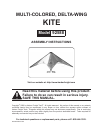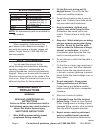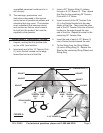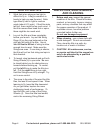
Page 4 For technical questions, please call 1-800-444-3353. SKU 92588
KITE FLYING TIPS
Wind that is too strong or too light is 1.
difcult to y in. A ag or windsock is
handy to help you see the wind. Delta
type kites y well in light to medium
winds (about 6-15 mph). If the Kite sinks
tail rst, there might be too much wind. If
the Kite comes down head rst or spins,
there might be too much wind.
Lay out the Kite and lines completely 2.
before you launch. Lay out the String
Rings (5) so they are balanced on the
right and left side of the Kite. Use at
least 60 feet to 90 feet of string to allow
enough time to react. Make sure the
Strings are even. If one string is shorter,
the Kite will pull on that string and spin in
that direction.
To launch,3. step backwards and pull both
String Wheels (4) to your side. Be sure
to check behind you for obstructions or
hazards before backing up. To control,
pull the left String to make the Kite turn
left. Pull the right String to turn right.
Hold the Strings even to y straight. Try
not to over-control.
The more to the side of the wind the Kite 4.
ies, the less lift and speed it has. When
learning to y, keep the Kite downwind.
As you get better, explore the more
challenging levels of performance. To
land the Kite, real in one of the String
Wheels (4). Once the Kite has landed,
real in the remaining String Wheel.
INSPECTION, MAINTENANCE,
AND CLEANING
Before each use, 1. inspect the general
condition of the Kite. Check for broken,
cracked, or torn parts, loose or missing
parts, and any condition that may affect
the proper operation of the product. If
a problem occurs, have the problem
corrected before further use.
Do not use damaged equipment.
When cleaning, 2. use a clean cloth with
a mild detergent. Do not use solvents.
Then, store the Kite in a safe, dry
location out of reach of children.
CAUTION! All maintenance, service, 3.
or repairs not listed in this manual are
only to be attempted by a qualied
service technician.






